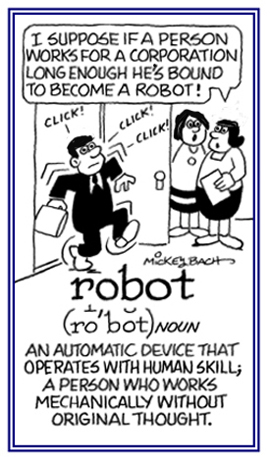Robots, Robotic Topics, and Robot References +
(background information about robots and applicable robotic terms)
New “robot” words have come into existence and are continually being created.
Microrobots typically have dimensions ranging from a fraction of a millimeter up to several millimeters.
A microrobot, like its larger and smaller cousins, the robot and the nanorobot, can be either autonomous or insect-like.
An autonomous microrobot contains its own on-board computer, which controls the machine and allows it to operate independently.
The insect scheme is more common for microrobots. In an insect-microrobot arrangement, the machine is one of a fleet of several, or many, identical units that are all controlled by a single, central computer.
The term "insect" comes from the fact that such robots behave like ants in an anthill or bees in a hive.
Mobile robots can move around in their environment and are not attached to one physical location; in contrast, industrial robots usually have a jointed arm (multi-linked manipulator) and gripper assembly (or end effector) that is secured in a fixed surface.
Nanorobots have dimensions on the order of nanometers (a nanometer is a millionth of a millimeter).
Nanorobots, like their larger counterparts, can be categorized into two groups, called autonomous robots and insect robots.
- An autonomous nanorobot contains its own onboard nanocomputer, which controls the machine and allows it to operate independently.
- An insect nanorobot is one of a fleet of several, or many, identical units that are all controlled by a single, central computer.
Nanorobots are of special interest to researchers in the medical industry because it has been suggested that a fleet of self-replicating insect nanorobots might act as a vaccine against disease.
Such nanorobots might even serve as antibodies or antiviral agents in patients with compromised immune systems, or in diseases that do not respond to more conventional measures.
The nanorobots would work by seeking out and destroying specific bacteria, fungi, or viruses and they have potential applications in the assembly of small-scale, sophisticated systems.
Nanorobots might function at the atomic level to build devices, machines, or circuits one particle at a time.
A major asset of nanorobots is the fact that the individual units require very little energy to operate and durability is another potential asset; since nanorobots might remain operational for years, decades, or centuries.
High speed is also a significant consideration for nanorobots because nanoscale systems can operate much faster than their larger equivalents because displacements are smaller which allows mechanical and electrical events to occur in less time at a given absolute speed.
Dr. Robot’s LCD screen displays the face of the medical provider-specialist controlling the robot.
The robots can be operated from anywhere, provided the user has access to a control station with a computer, internet access, and "mobile robotic" control software from the robot's manufacturer (InTouch Health).
Most of the patients who have had contact with the four-foot tall "doctor" have reported that they think "interacting with robotic caregivers is far more amusing and interesting than chatting with standard-issue, flesh-and-blood medical personnel."
Some people have even stated that "the robodoc was more enjoyable than a standard bedside visit".
Medical facilities in small towns or rural areas who may lack the resources to maintain a full staff of medical specialists could use the robots to provide remote consultations with experts who could work with patients, medical staff, and family members; whenever and wherever needed.
Robots also could stand in for humans when it's not practical or possible to physically send in physicians; such as, in military operations, natural or bioterrorist disasters, at sea, or in other remote locations.
Health-care workers need not fear that they will be replaced by “"bots", no matter how amused patients might be by the prospect.
Medical specialists believe that robo-doctors and robo-nurses can supplement care, but cannot replace their human counterparts; at least, not yet!
There is no consensus regarding which machines qualify as robots; however, there is general agreement among certain people that robots tend to do some or all of the following: move around, operate a mechanical limb, sense and manipulate their environment, and exhibit intelligent behavior; especially, behavior which imitates humans or other animals.
In reality, modern industrial robots have very little physical or no resemblance to humans. It depends on which robot a person is referring to.
2. Etymology: from Czech robota, "work, forced labor, drudgery."
Go to this Word A Day Revisited Index
so you can see more of Mickey Bach's cartoons.
2. An aircraft adapted to control by or through a preset self-reacting unit or a radio-controlled unit, without the benefit of a human pilot.
2. A small winged missile that is loaded with explosives, jet-propelled, and guided only by a gyroscopic robot device.
2. The process of creating a robot.


